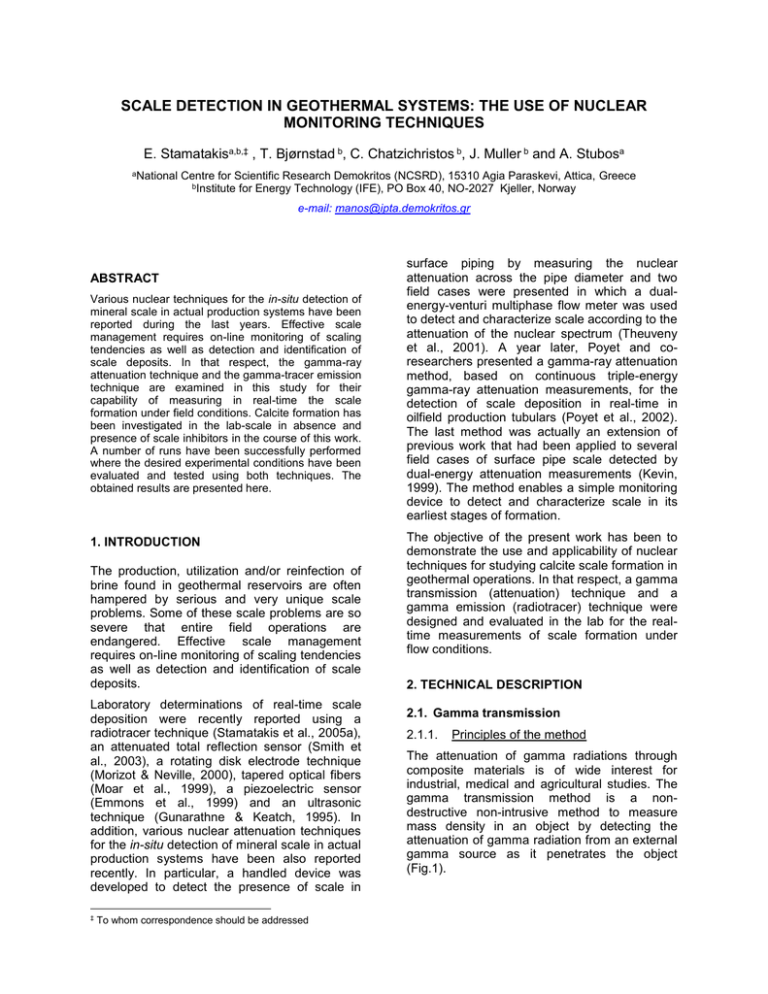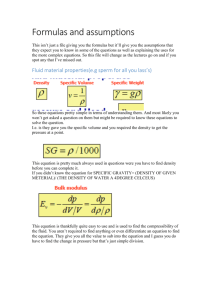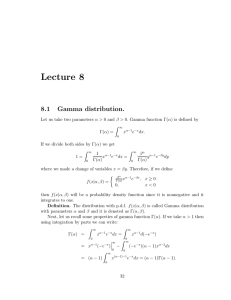SCALE DETECTION IN GEOTHERMAL SYSTEMS: THE USE OF NUCLEAR MONITORING TECHNIQUES
advertisement

SCALE DETECTION IN GEOTHERMAL SYSTEMS: THE USE OF NUCLEAR MONITORING TECHNIQUES E. Stamatakisa,b,‡ , T. Bjørnstad b, C. Chatzichristos b, J. Muller b and A. Stubosa aNational Centre for Scientific Research Demokritos (NCSRD), 15310 Agia Paraskevi, Attica, Greece bInstitute for Energy Technology (IFE), PO Box 40, NO-2027 Kjeller, Norway e-mail: manos@ipta.demokritos.gr ABSTRACT Various nuclear techniques for the in-situ detection of mineral scale in actual production systems have been reported during the last years. Effective scale management requires on-line monitoring of scaling tendencies as well as detection and identification of scale deposits. In that respect, the gamma-ray attenuation technique and the gamma-tracer emission technique are examined in this study for their capability of measuring in real-time the scale formation under field conditions. Calcite formation has been investigated in the lab-scale in absence and presence of scale inhibitors in the course of this work. A number of runs have been successfully performed where the desired experimental conditions have been evaluated and tested using both techniques. The obtained results are presented here. 1. INTRODUCTION The production, utilization and/or reinfection of brine found in geothermal reservoirs are often hampered by serious and very unique scale problems. Some of these scale problems are so severe that entire field operations are endangered. Effective scale management requires on-line monitoring of scaling tendencies as well as detection and identification of scale deposits. Laboratory determinations of real-time scale deposition were recently reported using a radiotracer technique (Stamatakis et al., 2005a), an attenuated total reflection sensor (Smith et al., 2003), a rotating disk electrode technique (Morizot & Neville, 2000), tapered optical fibers (Moar et al., 1999), a piezoelectric sensor (Emmons et al., 1999) and an ultrasonic technique (Gunarathne & Keatch, 1995). In addition, various nuclear attenuation techniques for the in-situ detection of mineral scale in actual production systems have been also reported recently. In particular, a handled device was developed to detect the presence of scale in ‡ To whom correspondence should be addressed surface piping by measuring the nuclear attenuation across the pipe diameter and two field cases were presented in which a dualenergy-venturi multiphase flow meter was used to detect and characterize scale according to the attenuation of the nuclear spectrum (Theuveny et al., 2001). A year later, Poyet and coresearchers presented a gamma-ray attenuation method, based on continuous triple-energy gamma-ray attenuation measurements, for the detection of scale deposition in real-time in oilfield production tubulars (Poyet et al., 2002). The last method was actually an extension of previous work that had been applied to several field cases of surface pipe scale detected by dual-energy attenuation measurements (Kevin, 1999). The method enables a simple monitoring device to detect and characterize scale in its earliest stages of formation. The objective of the present work has been to demonstrate the use and applicability of nuclear techniques for studying calcite scale formation in geothermal operations. In that respect, a gamma transmission (attenuation) technique and a gamma emission (radiotracer) technique were designed and evaluated in the lab for the realtime measurements of scale formation under flow conditions. 2. TECHNICAL DESCRIPTION 2.1. Gamma transmission 2.1.1. Principles of the method The attenuation of gamma radiations through composite materials is of wide interest for industrial, medical and agricultural studies. The gamma transmission method is a nondestructive non-intrusive method to measure mass density in an object by detecting the attenuation of gamma radiation from an external gamma source as it penetrates the object (Fig.1). Scale detection in geothermal systems: The use of nuclear monitoring techniques Figure 1 – Gamma transmission method Figure 2 – Schematic γ-ray narrow beam adsorption measurement through a composite sample. Transmission of a mono-energetic beam of collimated photons through a simple adsorption sample (as in Fig.1) can be described by the Lambert-Beer’s equation: I x I o e x (1) where, Ix is the intensity of the γ-ray radiation after passing through a material, Io is the intensity of the narrow beam monoenergetic γray radiation before passing through a material, μ is the linear attenuation coefficient (L-1) and x is the sample thickness. A quantity more commonly found tabulated is the mass attenuation coefficient μm=μ/ρ with dimensions L2/M. The mass attenuation coefficient represents the penetration and the energy deposition by the photons in materials. This can be obtained by the measurement of Io and combination with the confirmed values of Ix and x. Research has involved in obtaining this value for radiological interest, as this value is characteristic for each element, mixture and compound. Equation 1 gives the decrease of the gamma rays intensity for a homogeneous absorber. If the beam of gamma rays enters a different dense medium Eq.1 has to be modified. It can be easily shown that when a narrow beams of gamma rays passes through our test session (aluminum tube) to the forming calcite scale, and finally, to the liquid phase (see Fig.2), the attenuation is additive according to: I xm I o e 2 Al xm , Al 2 Ca xm ,Ca l xm ,l Al Ca l 2 (2) Here, xm is the so-called mass thickness with dimensions M/L2. The relation between the linear thickness and the mass thickness is simply x=xm/ρ. In case of CaCO3 scaling on the inner walls of an aluminum tube, the only unkown parameters are xm,Ca and xm,l. The contribution of the liquid thickness can be corrected for by calibrating the system by removing the liquid (mass attenuation of pure air can be neglected relative to CaCO3). Thus, xm,Ca can be uniquely determined. 2.1.2. Experimental system Figure 3 shows the schematic diagram of the experimental apparatus, which was designed and constructed for this study. Twin HPLC pumps drive two solutions, one containing scale forming cations (Ca2+) and the other anions (HCO3-). The solutions are pumped through two pre-heating tubes, which raise the solution temperature to the desired test temperature prior to arriving at the mixing point. The combined solution, which now has a positive saturation index, passes through our test session (1m long aluminium 6061 with 1cm ID) and scale crystals nucleate and grow on its internal surface. The temperature is maintained constant by a heating equipment fixed along the tube. Figure 3 – Experimental set-up illustration for the gamma transmission measurements. To monitor the forming scale, a narrow beam of gamma rays from an appropriately shielded radioactive source (133Ba) is directed through the tube; variations in the transmitted intensity recorded by a radiation detector positioned on the opposite side of the tube can then be related to the variations in the mass per unit area of the intervening deposited material (see figure 2). To obtain the final profile of the deposits, the tube can be moved across the mounted source and detector, and measurements were collected at certain intervals at the end of each run. 2.1.3. Typical results Typical primary results from this kind of experiments are given in Figures 4 – 8. For more detailed results see the work of Stamatakis and coworkers (Stamatakis et al., 2005b). Scale detection in geothermal systems: The use of nuclear monitoring techniques 3 1,00 4600 0,90 0,80 scale thickness (cm) count-rate (cps) 4550 4500 4450 background tind 4400 0,70 0,60 0,50 0,40 0,30 0,20 0,10 4350 0,00 0 5 10 15 20 25 30 0 10 20 time (hours) Figure 4 – Gamma transmission as a function of time at the liquid mixing point for calcite precipitation 30 Position (cm) 40 50 60 Figure 8 – The primary attenuation data converted to scale thickness distribution across the tube. 0,275 2.2. Gamma emission 0,250 Scale thickness (cm) 0,225 2.2.1. Brief outline of the method 0,200 0,175 0,150 0,125 0,100 0,075 0,050 0,025 0 0 5 10 15 20 25 Time (hour) Figure 5 – The primary attenuation data converted to scale growth rate. The basis of this method is to label the calciumcontaining liquid with the radioactive gamma emitter 47Ca (in the chemical form of Ca2+). The radioactive 47Ca behaves chemically identical to non-radioactive calcium. When calcium carbonate precipitates, 47Ca will be a messenger for where the precipitation takes place and to what degree (amount of precipitate). The gamma radiation from 47Ca will penetrate the tube and be detected by external detectors. In this way, the emission technique is an on-line non-intrusive and continuous experimental technique. The experimental setup is illustrated in Fig.9. Figure 6 – Scaling rates of calcite precipitation in the presence and absence of a scale-inhibitor. 7000 6800 background 6600 final Two energy-dispersive NaI(Tl) γ-detectors are for the on-line measurements of 47Ca activity. One is set at a fixed position (position ‘zero’ of the sand-pack), dedicated to measure accurately the induction time, while the other (γscanner) is used to monitor the growth of the calcite deposition along the sand-packs. This scanner-detector system is computer operated. 6400 cps 6200 6000 5800 5600 5400 5200 5000 0 10 20 30 40 50 Figure 9 – Experimental set-up illustration for the radiotracer technique. 60 Position (cm) Figure 7 – Gamma transmission measurements across the tube. The main gamma energy of 47Ca is 1297 keV. However, by including also its Compton background and lower energies in the counting window, the sensitivity in the experiment may be Scale detection in geothermal systems: The use of nuclear monitoring techniques increased. It is necessary to avoid contribution from 47Sc, which is the daughter nuclide in the decay of 47Ca (see Fig. 10). The energy window for the detectors will therefore be chosen from 350 keV and upwards to avoid the 159 keV γquanta from 47Sc. 4 needed, which can be found in the market. For example, enriched 46Ca (4.1%) is available to us, meaning that there is an 1000 times stronger target for irradiation. 2.2.3. Typical results Typical results, taken from a previous study (Stamatakis et al., 2005a) where higher saturation ratios were used (there was no need for enriched 46Ca), are shown in Figures 11 - 15. 200 1,0 Ca(47) tracer background Δp 175 0,8 Samples are also collected periodically at the exit end of the sandpack and the activity of 47Ca (1297 keV) in solution determined in off-line high-resolution detector gamma-spectrometric measurements with a HpGe-detector coupled to a multichannel analyzer. 125 0,6 100 0,4 75 Δp (bar) Figure 10 – Chart of nuclides count-rate (cps) 150 50 0,2 25 0 0,0 0 20 40 60 80 100 120 140 Tim e (m in) Solution temperature Ts, differential pressure Δp, pH, absolute system pressure p and 47Ca2+ activity (counting rate R) from the two on-line detectors are logged by computer during the experiment. Figure 11 – deposit growth at the liquid mixing point along with the differential pressure build-up over the tube as a function of time. 47Ca 11 0-30min 30-60min 60-90min 90-120min 120-150min after 4 hours background 10 2.2.2. The tracer 47Ca 9 has a half-life of 4.54 days, and has to be produced by thermal neutron irradiation of Ca (46Ca) in a nearby nuclear reactor (in this case at IFE). The following nuclear reaction takes place: 46Ca(n ,γ) th → 47Ca (γ-emitter) ti )e 7 6 5 4 3 Natural calcium contains only 0.004% of the target nuclide 46Ca. For low SR-values and reasonable uncertainty in the experiments, application of natural calcium as target material is insufficient. This argument will become clearer by studying the information in Eq.3 below showing the activation equation where the number of target nuclides (N = 46Ca) is one of the parameters. D (1 e count-rate (cps) 8 47Ca t d 2 1 0 0 1 2 3 4 5 6 7 8 9 10 11 12 13 14 position (cm ) Figure 12 – Distribution of 47Ca-containing scale along the tube at different time intervals. (3) where, σ = reaction cross section in cm -2 φ = neutron flux (ncm -2s-1) N = number of target atoms λ = decay constant (=ln2/T1/2) ti = irradiation time td = decay time In natural Ca there is not sufficient number of 46Ca-atoms to reach a disintegration rate, which is needed for saturation ratios in the order of 1.5 and slightly above. Calcium enriched in 46Ca is Figure 13 – 47Ca deposit growth at different inhibitor concentrations. Scale detection in geothermal systems: The use of nuclear monitoring techniques 5 turn results in more efficient decisions regarding scale treatments in the field. Such simulation tools are currently under validation for use in field scaling management procedures. In addition, the gamma transmission technique has been frequently used to detect scale formation in surface equipment at the field-scale. REFERENCES Figure 14 – Final distribution of along the whole tube. 47Ca-containing scale Emmons D.H., Graham G.C., Holt S.P., Jordan M.M. and Lorcardel B., “On-Site, Near-Real-Time Monitoring of Scale Deposition”, paper SPE 56776 presented at the SPE Annual Technical Conference and Exhibition, Huston, Texas (1999). Gunarathne G.P.P. and Keatch R.W., “Novel Techniques for Monitoring and Enhancing Dissolution of Mineral Deposits in Petroleum Pipelines”, paper SPE 30418 presented at the Offshore Europe Conference, Aberdeen UK (1995). Kevin K., “Operating Experiences for the World’s First Commercially Installed Multiphase Meters in the Liverpool Bay Field”, paper presented at the IBC Conference on Multiphase Flow Metering, London (1999). Moar P.N. et al., “Fabrication, modelling and direct evanescent measurement of tapered optical fiber sensors”, Journal of Applied Physics, 3395 (1999). Figure 15 – Calcite scale thickness distribution across the tube CONCLUSIONS Two different nuclear techniques have been designed and evaluated in the lab for the realtime measurements of scale formation under flow conditions. Both methods are capable to visualize the distribution of the scale deposits, a result that is not readily obtained by methods commonly used in conventional dynamic scaling experiments. Furthermore, the techniques are sensitive to scaling, resulting generally in shorter induction times compared currently employed methods (based on pressure drop). The methodologies can be easily used for the laboratory investigation of the scaling processes occurring in geological systems, including oilfield, geothermal and hydrology applications and for all kind of mineral scales. It should be noted that although the nuclear methods have been evaluated at the lab-scale, their results are meant to be applicable at the field scale. Indeed, the quantification of the earlier occurrence of scale precipitation that those techniques attain can be directly implemented in large scale simulators. This in Morizot A.P. and Neville A., “A Novel Approach for Monitoring of CaCO3 and BaSO4 Scale Formation”, paper SPE 60189 presented at the 2nd International Oilfield Scale Symposium, Aberdeen, UK (2000). Poyet J-P., Ségéral G., Toskey E., “Real-Time Method for the Detection and Characterization of Scale”, paper SPE 74659 presented at the 4th International Oilfield Scale Symposium, Aberdeen, UK (2002). Smith J.K., Yuan M., Lopez T.H., Means M. and Przybylinski J.L., “Real-Time and In-Situ Detection of Calcium Carbonate Scale in a West Texas Oilfield”, paper SPE 80372 presented at the 5th International Oilfield Scale Symposium, Aberdeen, UK (2003). Stamatakis E., Haugan A., Dugstad Ø., Muller J., Chatzichristos C., Bjørnstad T., Palyvos I., “Validation of Radiotracer Technology in Dynamic Scaling Experiments in Porous Media”, Chemical Engineering Science, 60/5, 1363-1370 (2005a). Stamatakis E., Muller J., Chatzichristos C., Haugan A., “Real-time monitoring of calcium carbonate precipitation from geothermal brines”, technical report, presented during the European Hot Dry Rock Association (EHDRA) Scientific Meeting, Soultz-SousForêts, France, 17-18 March (2005b). Theuveny B., Ségéral G. and Moksnes P.O., “Detection and Identification of Scales Using Dual Energy / Venturi Subsea or Topside Multiphase Flow Meters”, paper OTC 13152 presented at the Offshore Technology Conference, Houston, Texas (2001).



